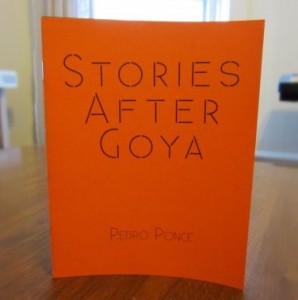$8.50
Review by Claire Jimenez
Pedro Ponce’s chapbook Stories After Goya is a collection of six vignettes inspired by Francisco de Goya y Lucientes’s “Los Caprichos,” a series of etchings depicting different scenes from Spanish life in the late 18th century. In “Los Caprichos,” Goya incorporated elements of the supernatural that emphasized the greed, hypocrisy, and corruption of Spanish nobility and the Inquisition. In the series, Goya’s clergyman look like trolls, his prostitutes like witches. Like Goya, Ponce also tries to reflect the uglier aspects of contemporary culture and politics in the United States, but this time using story. Ponce, like Goya, also incorporates a vocabulary of otherworldly metaphors to make our own reality look strange.
In other stories that Ponce has written before this collection, such as “The Piazza de Chirico,” he turns spaces and institutions into characters with their own beginnings, endings and arcs, showing us that place does in fact have power. Ponce is also good at shifting the reader’s attention to systems that operate sometimes invisibly, while also making them strange to us. Similarly, Stories After Goya defamiliarizes the subject, so that we’re not completely sure what we’re looking at, even when some of the details feel familiar. The stories in this chapbook are often narrated through a weird plural first person “We,” making the reader feel like a tourist wandering through a strange dream that at times resembles life. At its best moments the chapbook, like Goya’s paintings, forces the readers to recognize the darker parts of themselves that they did not want to see.
My favorite of the stories, “Golden Door,” which explores immigration, begins: “With the coming of the warm months, we are free to stroll the cobbled paths between boutiques and baristas, our fingers dripping lemon ice. The quarantine wards are always full this time of year. We gather at the protective glass to greet the newest carload of aspiring citizens.” Then later: “Translators are provided, but we find ourselves most moved by those who try to master our language. Their struggle with accent and malapropism only serves to underscore their eagerness.” I love these sentences, because they capture something strange and awful about contemporary life in the United States, one split into two worlds, where some of us are “free” to enjoy cobbled paths and desert, while others are trapped behind this invisible glass, struggling and eager to find the language in order to be accepted.
My biggest critique is that there are parts of the chapbook that feel vague, as if there are other stories needed in the collection to fully understand the ones given to us. In one interview, Ponce notes that the chapbook is a scaled down version of a larger collection that at one point became unwieldy, so he cut some of the stories out. I disagree. I think there’s an opportunity here to include more stories that between them would more fully build this world, perhaps with a repeated vocabulary of images. Ultimately, though Stories after Goya is a wonderful beginning, and I hope to read more.
***
Claire Jimenez is a graduate of Vanderbilt University’s MFA program in fiction. She lives and writes in New York.
![[PANK]](https://pankmagazine.com/wp-content/themes/pank/assets/images/pank-logo-large.png)

